Destroy All Monsters (1968)
Directed by: Ishirô Honda
Written by: Ishirô Honda, Takeshi Kimura
Starring: Akira Kubo, Jun Tazaki, Yoshio Tsuchiya, Yukiko Kobayashi
HCF REWIND NO.133. DESTROY ALL MONSTERS AKA KAIJU SOSHINGEKI, ATTACK OF THE MARCHING MONSTERS [Japan 1968]
AVAILABLE ON DVD
RUNNING TIME: 89 min
FEATURED MONSTERS: GODZILLA, MINILLA, MOTHRA, RODAN, ANGUIRUS, GOROSAURUS, BARAGON, KUMONGA, MANDA, VARAN, KING GHIDORAH
REVIEWED BY: Dr Lenera, Official HCF Critic
In the year 1999, all of the Earth’s monsters have been collected and confined by the United Nations Science Committee on Monsterland aka Ogasawara Island. A special control centre is constructed underneath the island to ensure the monsters stay secure, and even serves as a research facility to study them. When communications with Monster Island are suddenly severed, and some monsters have attacked world capitals, Dr. Yoshida of the UNSC orders Captain Katsuo Yamabe and the crew of his spaceship, Moonlight SY-3, to investigate Ogasawara. There, they discover that the scientists have become mind-controlled slaves of a feminine alien race identifying themselves as the Kiraku, who reveal that they are in control of the monsters. Their leader demands that the human race surrender, or face total annihilation…..
Destroy All Monsters is a firm favourite with many Toho monster movie fans, and that’s probably for one main reason; it features eleven monsters, something which only 2004’s Godzilla Final Wars beat, and you could say that doesn’t really count because some of the monsters in that film only appear as stock footage. In any case, no other films even approach the number of monsters in these. This means that there’s little room for human characterisation or even plot, and what story Destroy All Monsters has is cribbed from Invasion Of Astro-Monster and Battle In Outer Space, almost coming across as a remake of those two films. But who cares when the result is so entertaining, a thrilling romp packed with action that never slows down for a moment. A few films back I reviewed Ghidorah The Three-Headed Monster and said it was probably my favourite Godzilla film. Now, as I write this review after having seen this glorious piece of entertainment, a film which never fails to make me smile after a bad day at work, yet again, I’m not so sure, though as a film Destroy All Monsters does have a few notable flaws that prevent it from being quite as great as it should be considering its large cast of monsters.
It’s now hard to believe considering the number of films that came after it, but Toho originally planned to end the series in 1968 due to dwindling box office returns. The films weren’t even being shown theatrically in the US any more. It was decided to end things on a high and bring back most of Toho’s monster cast. Takeshi Kimura’s original screenplay was titled All Monsters Attack Directive, which I suppose isn’t that different from Attack Of The Marching Monsters, the eventual Japanese title. Originally Maguma the giant walrus from Gorath and Ebirah the big crab from Godzilla Vs The Sea Monster were going to be in it, but were replaced by Anguirus and Gorosaurus. Baragon from Frankenstein Conquers The World was also going to play a bigger role, and some scenes in the film were going to explore the idea of undersea farming, but that fell by the wayside. New suits were built for some monsters, not for others. A brief scene of Godzilla battling Manda during the Tokyo destruction sequence was cut, supposedly because the special effects were weak. Ghidorah’s fiery birth from his debut film and some shots of the exploding Red Bamboo base from Godzilla Vs The Sea Monster were re-used. The film made slightly less than Son Of Godzilla, but was very successful in the US, released by AIP with a couple of minor alterations, like moving the opening credits and music to the end. It became one of the most popular Toho pictures in the west even when it was unavailable for many years. And of course Toho decided to continue the series.
This is one fast-paced, action-packed movie. No sooner have we been introduced to the wonderfully daft concept of Monsterland, more commonly known as Monster Island [how did they manage to round up all those monsters?], than the Kiraku attack the scientists there with their gas. After this the film mostly alternates monster attack scenes with our heroes in their super spaceship going all over the place, even to the Moon, to find out what is controlling the monsters and to defeat the Kiraku. Unlike those of Shinichi Sekizawa, who had written all of the Godzilla films except from the first and the second, Kimura’s screenplay doesn’t bother with building up to the thrills and the monster’s appearances, nor does he even really bother with human characterisation. The people here are ciphers, existing to propel the story and no more, a story in which every scene is a direct response to the one before it. This weakens the film as much as strengthens it; yes, the pace never slows, but we never really care about heroic astronaut/ all-purpose hero Katsuo and his crew as much as we should, despite the constant peril they find themselves in.
You certainly get your money’s worth regarding monster footage though, and for once we really get a sense of world peril as we briefly see Moscow, Paris and New York [oddly Godzilla destroys the United Nations building, showing that maybe Honda was less enamoured of the UN by now] attacked, though the monsters seem to get to their destinations extremely quickly. Of course it’s Tokyo that gets the full treatment, with Godzilla, Mothra, Manda and Rodan all turning up to wreck it, though the missile attack by the military perhaps destroy more buildings than the monsters. One especially cool shot has Manda, the sea serpent, snake round part of a monorail and destroy it while Godzilla obliterates a building with his breath in the distance. And then, after some more confrontations with the army and much rushing around in the SY-13, we get to the climax, where all the monsters, freed from alien control, march on the Kiraku base at Mt. Fuji [of course], replete with a news announcer reporting on the action. Their battle with King Ghidorah is an elaborately choreographed combination of suit acting and wire work, though it’s notable that some monsters hardly do anything, and why do the aliens send just one monster anyway when surely they know he wouldn’t stand a chance?
Some monsters get short shrift. Varan [the unbelievable] only appears in two quick shots! This was because some suits were in bad condition and they couldn’t afford to build too many new ones. Of them Godzilla is now far friendlier-looking with a slimmer, more human-like body, a longer neck , a more rounded head, larger mouth smaller fins and a shorter tail, Rodan has a more bird-like head but cruder-looking wings, Ghidorah also has simpler [and rather kite-like] wings, Anguirus is improved with a scalier skin, and Manda loses some of the dragon-like features on his head, looking more snake-like. Oddly Minilla looks the same though surely he should have grown considering this is supposed to be taking place way after the events of Son Of Godzilla? A ‘fire dragon’ turns up at the end but turns out to be just a flaming flying saucer. The effects by Teisho Arikawa, though supposedly ‘supervised’ by Eiji Tsuburaya, are good, if not quite up to the standard of late 50’s/early 6o’s Toho. The slightly reduced budget means that the model work is a little simpler, the sets, though often expansive, being not very detailed, and there’s not too much elaborate matte work, but it’s still all decent. Sadly, there are some sloppy bits in the film, like the announcer saying Baragon is attacking Paris when it’s Gorosaurus [albeit coming out from the ground like Baragon], Godzilla’s breath having to be curved because Haruo Nakajima is looking at the ground rather than a building, and one weird bit where a man throws himself out of a window, lands on some vegetation, yet in the next shot is lying on a beach. In a way of course, all this adds to the fun.
Honda nonetheless seems to be enjoying himself, perhaps because he thought it was his last Godzilla film. There are some creative shots, like three people framed in the circular panels of a hotel room’s partition, and a larger number of close-ups than normal. Oddly though this is a bloodier affair than usual for Honda, with a gory autopsy, Katsuo yanking the alien controls off his sister’s ears leaving them dripping blood, and even some monster grue. The cast all do fine but are given little room for characterisation. Akira Kubo is certainly charismatic as Katsuo, and Kyoko Ai has a rather sinister beauty as the Queen of the female Kiraku aliens. She is even given a nice moment where she resigns herself to defeat. Akira Ifukube’s score has one of his most memorable marches, very jaunty and upbeat, though much of it is slightly reworked earlier stuff. Alongside the Godzilla/Rodan theme [in probably its best arrangement] and Ghidorah theme you also get a variation on the Invasion Of Astro-Monster alien music for the Kiraku, another use of the frantic music heard most frequently in Dagora [the scene in which this appears in is rather funny, Katsuo and co. taking ages to sever a controlling device, the music making it funnier], and a snippet of Baragon’s theme [but not describing Baragon]. Not much is new, and you could really say that about Destroy All Monsters generally, but it’s such fun it hardly matters. It’s not the best Toho or even Godzilla film, but it might be the most essential. If you have to see just one, than I guess this is probably it.
How cool is the above picture?

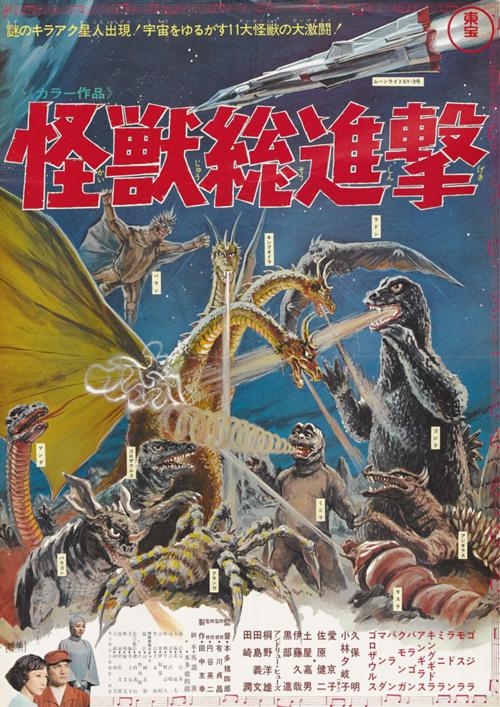
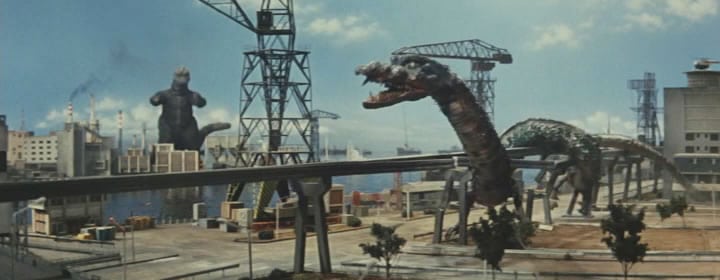




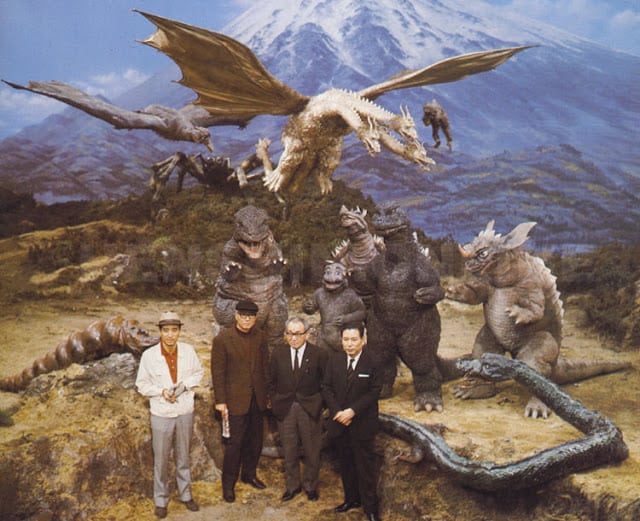


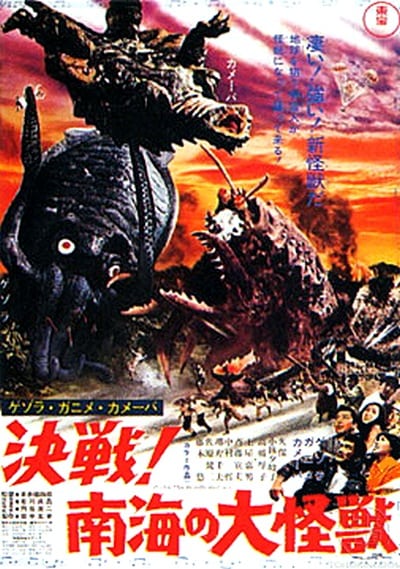
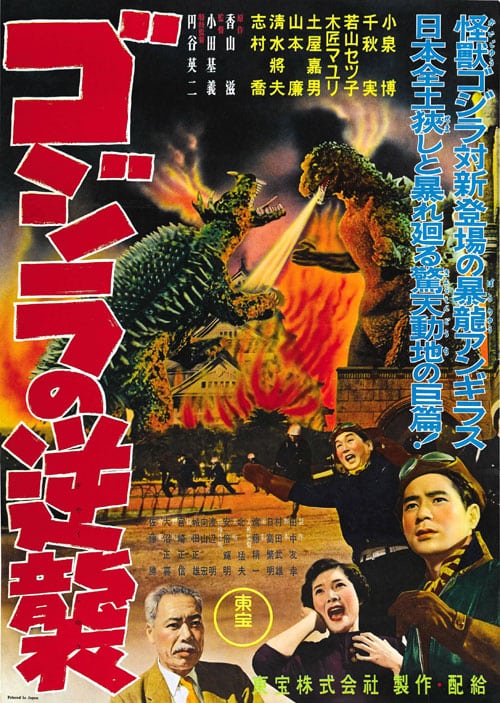
Be the first to comment